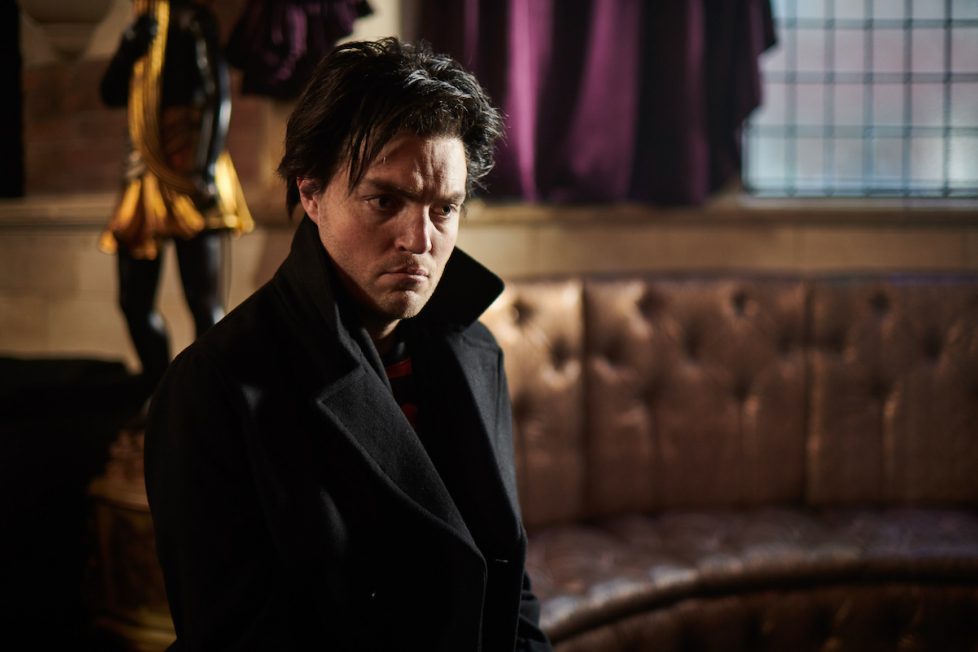THE SHOW (2020)
A man's search for a stolen artifact leads him to the haunted town filled with voodoo gangsters, masked adventurers, Depression-era private eyes, and violent chiaroscuro women.

A man's search for a stolen artifact leads him to the haunted town filled with voodoo gangsters, masked adventurers, Depression-era private eyes, and violent chiaroscuro women.


Alan Moore is the grand old man of graphic novel writing (Watchmen, Swamp Thing, From Hell), and there’s little doubt that The Show—in which he also makes a scene-stealing appearance—will be watched eagerly by his many fans. For other viewers, however, The Show may come across as clever, often original and witty, but deeply engaging. It’s a collection of good ideas that never offer much reason to care about them beyond the undeniable fact it’s fun enough while it lasts. Fun does, of course, count for a lot, and if The Show largely fails in persuading viewers to invest much in the ultimate fate of its characters or the solution to its mysteries, it’s consistently fresh enough to keep you just interested enough.
The Show starts with a Google Earth-like zoom into central England, where the setting’s revealed to be the town of Northampton—something of an in-joke for Brits, given the drab reputation of an area more associated with credit card statements and distribution hubs than heroics or high romance. It’s also Alan Moore’s hometown.
We soon meet the protagonist (Tom Burke), whose name we early on believe is Bob Mitchum (get it?), although a different truth, or possible truth, later emerges. He’s seeking a missing friend, or maybe he’s a detective seeking a man who wasn’t a friend, or maybe he’s something else, but in any case he clearly has a quest. It leads him—in a film that can’t be faulted for lack of pace, thanks to Mitch Jenkins’s direction and Colin Goudie’s editing, as well as Moore’s writing—to a masked superhero librarian-hacker, a hospitalised journalist, a burned-out working men’s club, a pair of old-time comedians (one of them played by Moore dressed as the Man in the Moon), a magic cult, W.B Yeats, the Rosicrucians, foul-mouthed Britcrime geezer-gangster stereotypes, and many more.
Along the way there are revelations about key characters (“You’re a hitman?”—“We prefer exit technician”), plenty of meta-textual stuff (the Gunpowder Plot is compared to modern film, all “big explosions and no plot”), numerous dream sequences, colours and lighting as exaggeratedly unreal as the story, a wild assortment of camera angles and positions, some nice one-liners (“I see dead people”—“You work in a hospital”) and several memorable characters.
Unfortunately the leads—Burke’s man-on-a-mission and, at least in terms of the attention the film pays to her, the reporter Faith (Siobhan Hewlett) who becomes a kind of sidekick–aren’t as memorable. It’s difficult to be sure how much their woodenness is intentional, in a film that’s so pointedly self-aware and so big on non-naturalistic, wryly expository dialogue. If Hewlett seems like an actor acting an actor acting a part, and Burke delivers lines as if someone else has written them rather than his character thinking of them, that may be part of the intended effect.
All the same, it’s the performers in smaller roles who stand out, notable among them Ellie Bamber as a young woman who temporarily shares a house with Burke and can’t conceal her interest in him (“Any time I can tempt you with a steaming entrée, I’d be glad to”), Eric Lampaert as a DJ-cum-Hitler impersonator, and a wonderful Julian Bleach as hospital attendant Clive, made up as pale as a cadaver and going on about near-death experiences.
They, as much as any specific events, create the atmosphere of the movie—part Moore’s own League of Extraordinary Gentlemen, part BBC comedy League of Gentlemen, part David Lynch, part Guy Ritchie—abetted by an often amusing score and some droll visual touches (‘I brake for poignant memories’ says a bumper sticker).
Sequences where Burke encounters two young boys (Oaklee Pendergast and Ethan Rouse) playing at detectives, shot noir-ishly in black-and-white and even featuring a reference to the “legendary Maltese Cross” (presumably a Falcon by any other name), add much to the surreal ambience and are beautifully handled by the actors and cinematographer Simon Tindall, even if they add little to the convoluted (and perhaps not terribly important) thrust of the purported story.
The Show carries on from Show Pieces, a series of short pieces also based on Moore’s work, set in Northampton and directed by Jenkins, and indeed it often feels like a bunch of short film excerpts stitched together. The deeper points it repeatedly tries to make about existence, reality, and dreaming tend to be lost in this chaos—although it’s not clear whether they’re meant seriously or are merely fanciful diversions anyway. Any sense of real plot or peril, or credible characters, is similarly drowned in the sheer volume of crazy stuff going on.
But minute-to-minute, at least, the crazy stuff is often highly watchable even if the film as a whole doesn’t hang together well enough to make a bigger impact. Take it as the story-driven horror-noir it superficially sounds like, and it’s bound to be disappointing… but take it as a succession of sketches and it’s sure to entertain.
UK | 2020 | 115 MINUTES | 2.39:1 | COLOUR | ENGLISH

director: Mitch Jenkins.
writer: Alan Moore.
starring: Tom Burke, Ellie Bamber, Antonia Campbell-Hughes, Babou Ceesay, Christopher Fairbank & Siobhan Hewlett.
